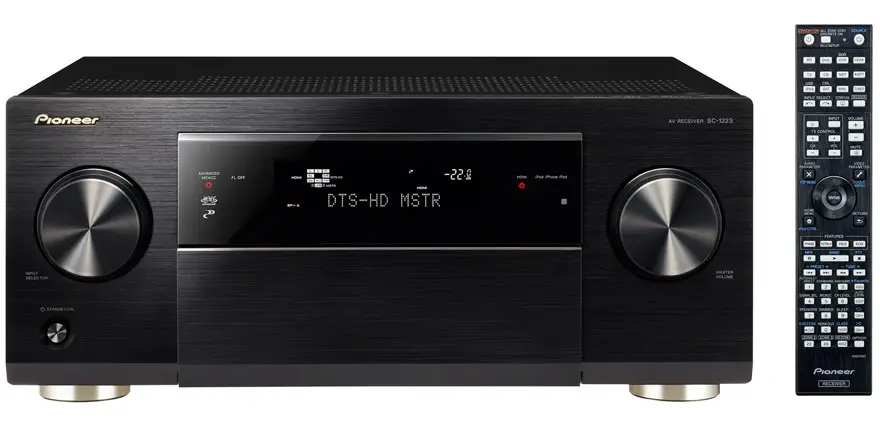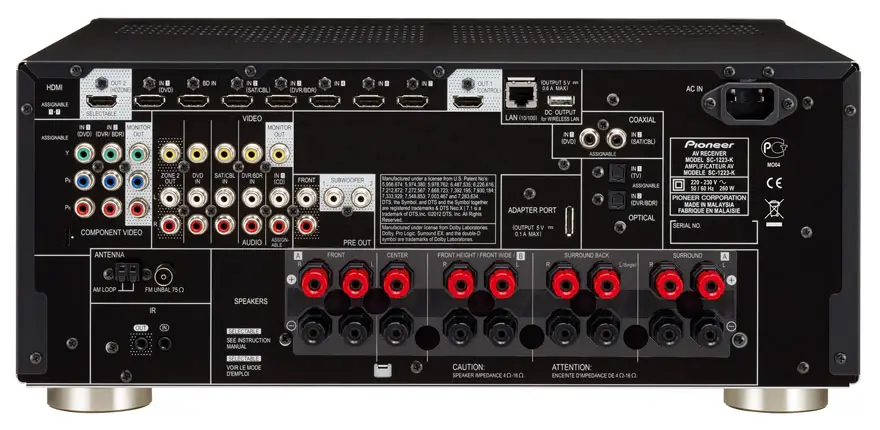The future of TVs and home theater systems is pretty exciting. 4K Ultra HD displays are already trickling out of the market and it is expected for these large beautiful displays to drop in price in the upcoming years. Smartphone and tablets are also playing a bigger role in supplying the home theater system with content without the wires. Of course, a very good home theater receiver is needed if you want a high-class audio experience. There are plenty of old but affordable receivers out there that have high output power specifications. However, getting the newest receivers is still recommended even if they are more expensive because they come with full support of next-generation technologies like 4K and enhanced smartphone connectivity. The Pioneer SC-1223-K is a good example of taking the very best of the previous model (SC-1222-K) and modernizing it with features thereby making it future proof for at least the next 5 years or more.
Design
People really liked the brushed metal finish that was used on the front panel of the SC-1222-K so Pioneer made the easy choice to make the design of the SC-1223-Ksimilar. Being part of the SC series, you are only limited to using the volume and input selection knobs. In order to operate the other functions, you either have to use the remote control or app or open the panel just below the display. Opening this panel is also necessary if you want to access the USB, HDMI, phones and setup mic ports. The front HDMI port is special since it supports MHL allowing newer smartphones to connect to the receiver and send high-definition audio and video data.
The differences between the Pioneer SC-1223-K and SC-1222-K are more noticeable when you start looking at the receiver from the back. The SC-1223-K actually lacks a few things that were present in the SC-1222-K including the RS-232 port, Zone 3 out and several pre outs. Fortunately, the Pioneer SC-1223-K has 1 more HDMI input than the SC-1222-K bringing the total of HDMI ports to 8 counting the one of the front and 2 HDMI outputs.
Below is the back panel layout. Click on image to enlarge for a clearer view.
Features
This home theater receiver is still worthy of the SC-1223-K name because it uses Pioneer’s proprietary Class D3 amplification design unlike the cheaper VSX models that use a discrete direct energy design. This basically highlights the receiver’s support for the newest high-resolution audio formats including Dolby Pro Logic IIz, TrueHD, DTS Master Audio, FLAC and several others. The Pioneer SC-1223-K is 4-OHM certified as well so you can safely hook up any low-impedance speakers you may have without running into any surprising issues. The total power output for all channels maxes out at 560 watts (8 ohms) which technically makes the SC-1223-K slightly less powerful than the 600-watt SC-1222-K. But when it comes to the actual audio quality, the Pioneer SC-1223-K is still very good because of the high efficiency of the Class D3 amplifier design. Only a very small amount of that power is converted to heat while the rest is fully focused on delivering all the little aspects of the sound.
The SC-1223-K also combines powerful specifications with ease of use. If have less experience in setting up an AV receiver or frequency stumble across problems in the installation process, you can install the free AVNavigator in a PC, Mac or iPad system and connect both the system and receiver to the same local area network. This network setup lets the receiver bring up a handy interactive user manual that you can use to do things like setup your speakers, calibrate the room and acquire firmware updates.
Calibrating the speakers in the room is the fun part because it uses the Advanced Multi-Channel Acoustic Calibration technology. This technology isn’t new and it works like last year’s model by taking the size of each speaker as well as the distances of the speakers into consideration when coming up with proper settings for the speakers. Exclusive to 2013 AV receivers including the SC-1223-K is another handy technology called PQLS or Precision Quartz Lock System which significantly improves the audio quality of Blu-ray titles running on a compatible Blu-ray receiver. By using the receiver’s own high precision clock, audio quality isn’t lost when transmitting Blu-ray audio data. You can also use Virtual Depth to add some nice depth to your soundstage which can be beneficial if you are into 3D movies.
The other new feature that the Pioneer SC-1223-K brings to the table is full 4K Ultra HD support. This means that the receiver is fully ready to accept any home theater components that can send 4K content to those large 4K displays. Many new home theater receivers support this emerging resolution too but may not come with upscaling support. The SC-1223-K has this feature which is nice if you already have a 4K display and wish to see 1080p and other low-resolution content upscale on the large display so the picture still looks clear.
Like other high-end Pioneer receivers, the Pioneer SC-1223-K has an extensive set of networking features. You can buy a wireless LAN dongle to connect the receiver to the router or use an Ethernet cable instead. Regardless of the approach, iOS and Android devices can be used to remotely control the receiver using an app called iControlAV2013. It also supports AirPlay and HTC Connect which are 2 significant technologies that allow iOS devices and HTC Android devices to easily share music and playlists with the receiver. Windows 8 certification also allows any computers or tablets with Microsoft’s latest operating system installed to stream music as well. If you don’t have a huge music collection, you can always take advantage of the receiver’s built-in support for Pandora, vTuner and SiriusXM Internet services.
Bottom Line
Picking the Pioneer SC-1223-K over the older model means that you are making some tradeoffs. If you are happy for the powered Zone 2 audio support and really need the 4K and/or MHL support, the Pioneer SC-1223-K is worth considering and the receiver still sounds great. The SC-1223-K is also a sensible purchase since the $999 price tag makes this receiver cheaper than the SC-1222-K when it first came out. The SC-1222-K might be a bit cheaper right now but that receiver is stuck in the past with no 4K and MHL support and fewer HDMI ports.



